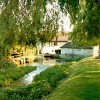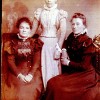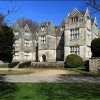When in 1213, King John found he needed the production of rope and sailcloth for his navy’s ships increased; he issued a Royal decree to the effect. To make the canvas for the ship’s sails he looked to Bridport as the place most appropriate for the nature of the task in hand. The king stated: “You cause to be made in Bridport night and day as many ropes for ships large and small and as many cables as you can and twisted yarns of cordage for ballistrae.”
Why Bridport? The raw materials for making sails at that time were flax and hemp. The climate made much of Dorset and the South West in general ideal for the cultivation of these crops. In particular the position of Bridport near the English Channel made the town ideal for locally growing flax and hemp for export, crops essential in the manufacture of rope and sailcloth. This established the town’s tradition as a centre of the flax, hemp, twine, rope, netting and sailcloth industries from Saxon times, when the town was one of only four Royal burghs.
The tradition of rope and net making in the area can be traced back to Roman times, as rope-line was needed for such jobs as catching fish and tethering animals. However, when the villagers of nearby Burton Bradstock began making rope in the 16th century Bridport objected and petitioned Parliament for trade protection against it. In response, Henry VIII, then actively building his rope-and-sail dependent navy, enacted a law in 1530 prohibiting any cordage-making within a five mile radius of the town.
Bygone production of rope involved a surprisingly long apprenticeship and a very crude form of weaving carried out in long passageways called ropewalks, several of which can still be seen around Bridport today. They are preserved as unusually long and narrow backyards or gardens, particularly in the area of the west side of South Street. Several workers, usually women with thick loops of yarn around their waists would stand at one end of the passage. They fed out the thread towards another roper positioned at the other end of the passage or open path. Who operated a machine like a spinning-wheel which plaited the yarns into twine and then into finished cordage. Already by the 14th century Bridport was the foremost producer and supplier of white, black and “bastard” thread and rope in the country and for more than seven centuries the town has been at the forefront of net-making technology.
The proximity of the Channel became an economic convenience because by the mid-19th century Bridport’s cordage and net industry was still very much a family concern. Of the local families engaged in the business those of Grundy and Houndsell were especially significant. The Gundry’s were rope and net makers who founded what has become today the BRIDPORT GUNDRY GROUP, a world leader in the manufacture of specialist textiles and netting. Today, Bridport-made nets are used by fishing fleets the world over. Bridport-Gundry also makes a whole range of other nets: for the tennis courts at Wimbledon and elsewhere, international airlines, even the ‘arrester’ nets for the space shuttle.
William Houndsell founded a water-powered spinning mill on the Brit in 1670 to make hemp yarns and fishing twines; from this a concern under the name of WILLIAM HOUNDSELL & Co was in existence by the end of the 18th century, which in turn became amalgamated as HOUNDSELLS (Bridport) LTD in 1913. During the 19th century there was a sharp rise in production to meet the needs of a rapid expansion in the cod fishing industry off the Grand Banks of Newfoundland. Indeed, this association resulted in some Houndsells emigrating to the New World. The business was still in existence in 1935 as ROBERT HOUNDSELL & Co.
In the late 19th and early 20th centuries the traditional long rope and spinning walks west of St. Michael’s Lane developed into St. Michael’s Works (now Bridport Industries.) Priory Mills for example, was steam-powered by the 1840’s and used the adjoining fields as drying areas for its products; it was the first purpose-built spinning mill in Bridport. The Stover Place Works and some other small scale textile concerns making netting and ropes, together with homes, were built for the workers in Ropewalks. Today the town is dominated by the extensive Court Mills works, including warehouses and a museum developed from the core of another 19th century mill.
Back gardens remained as long rope walks and the fields behind the main streets were still cultivated, including the glebe land of St. Mary’s Church. Until well into the 19th century the weaving of cloth and nets in Bridport was contracted to women outworkers employed at home in outlying farms and villages. The Industrial Revolution had a market effect on Bridport’s cordage and net industries. While the centralisation and mechanisation of the textile industry throughout the country generally came with this revolution in the mid 18th century, in Bridport the process remained labour intensive and home or workshop-based for longer than in Northern England, in fact until the mid 19th century.
At the start of the 19th century the textile industry, at least in the north, was experiencing something of a slump. While Bridport drew its workers mainly from the local population, some depressed northern weavers migrated to southern England in search of employment, including to Bridport, where there was still demand for skilled weavers because of the need for sailcloth. The introduction of mechanisation into the industry in Bridport coincided with the time the town began to specialise in net production for the fishing fleet and export.
The cottage industry then generally ceased when power looms were introduced into the Bridport works in 1851 – coincidently, the year of the Great Exhibition that included, among many other inventions on display, a power loom. Work based at home, along ropewalks, or in workshops was replaced by multi-storey mills powered by water or steam that industrialised the south-west quadrant of Bridport between the River Brit and South Street.
The legacy of this development is the fascinating industrial archaeology landscape of much of Bridport today.



